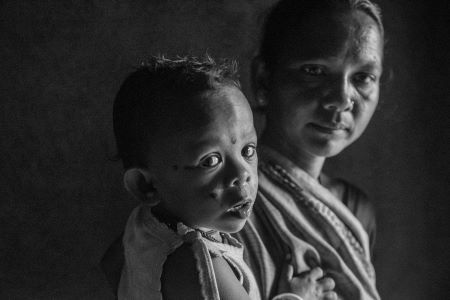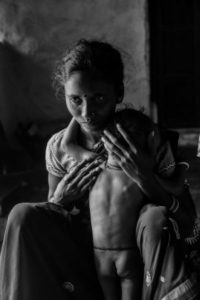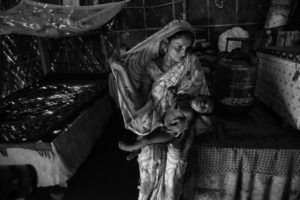He shoots to make a difference

Saurabh Tankha
SUDHARAK OLWE says he believes in visiting villages – to see the country in its rawest form, interact with people there and understand their lives and issues. Along with this, a good amount of time, he says, needs to be spent seeing other people’s works and talking to them. The Akola-born photojournalist, recipient of the Padma Shri in 2016, showcased a new collection of his photographs at the Art Gallery of Bikaner House in New Delhi recently.
Titled Endangered Species: Malnutrition Stalks India’s Children, the exhibition featured eye-opening images from the states of Assam, Chhattisgarh, Jharkhand, Maharashtra and Odisha and threw light on the plight of marginalised and poverty-stricken tribal groups, tea garden labourers, farmers, migrant workers, floodplain residents and documented the serious challenges in nutrition faced by them.
Excerpts from an interview with Olwe…
When was the first time you realised that your camera could act as a tool of change?
The first time photos from the In Search of Dignity and Justice project were published and the conversations it started in both the media and public made me realise that photos or the camera had the power to initiate change or act as a tool. The photos were widely circulated and when the book made its way to Ratan Tata, he immediately released funds and started projects via Tata Trusts for the uplift of these workers and families. Over the years, this idea has helped me maintain a steady focus on subjects and issues that need attention. Having also successfully done workshops with the children of conservancy workers, children in rural and tribal India, I have felt that the camera acts a great tool of change in communities by providing a medium to talk about issues and also as an alternate livelihood.
How difficult was it to act as a medium of change?
There were obstacles at every stage and there still are. But the hope and resilience that radiates from the people we want to help and who we want to give a voice acts like weapon that shatters these obstacles. I only tell stories and ask people to listen to them. Change is a direct or an indirect product from that.
Tell us more about Endangered Species: Malnutrition Stalks India’s Children.
A total of 8.82 lakh Indian children under the age of five died due to malnutrition in 2018 and we rank at 102 in the global hunger index. Reading such alarming statistics truly made us wonder what the true state of India’s children is. Over the years while shooting other subjects like maternal mortality or infant mortality, malnutrition and hunger always came up. For the past few months, I travelled to Chhattisgarh, Assam, Odisha, Jharkhand to try to document the issue and causes of malnutrition and severe acute malnutrition.
In Assam, malnutrition was highly prevalent in the tea tribes who have faced decades of injustice and live in extreme poverty and in Muslim migrants who have been deprived of essential services like Anganwadi centres, while the state lacks infrastructure and governmental will to fight this menace.
In central Indian states, remote locations and lack of proper services hampers the work being done while tribal customs and superstitions also play a role in propagating malnutrition. The problem is as complex as our huge country but not something that cannot be tackled. For me, it was important to tell the human story. The stories of the mothers and children who are affected the most. It was an eye-opening experience and there is an urgent need to talk about malnutrition in our country now. Hence the exhibition.
You said somewhere that ‘one learns with experience and not just with degrees and diplomas.’ What makes you say that?
As a photographer, it is important to pick up the camera and shoot and talk to people and travel. You can read hundreds of books or write many papers, but unless you take your camera, point it and shoot — you will not learn. Experience and talking to people has been my greatest teacher — visiting villages, seeing your own country in its rawest form, interacting with the people there and understanding their lives and issues. Along with this, a good amount of time should be spent seeing other people’s work, talking to them. In photography or journalism, you are constantly evolving and learning.
Having worked with various newspapers, national and regional, over the last three decades, what changes have you observed from the times when you started working to now, both professionally and personally?
Earlier, there were hardly any photographers. Just a few of us in the city covering events or important news and incidents. The quality of work was definitely better. Now there are hordes of photographers and even though there are really good photographers in the bunch, a lot of good work is drowned in the continuous barrage of images and videos. It’s also a good thing because people now have good access to information but it also means it takes time to weed out the really good photographs. Today, not many stop and see or feel. It is important, now more than ever to truly understand an issue, to learn, to have empathy. This is sorely missing these days.
How much of a difference do awards make?
Awards and grants are great lifelines for independent journalists and photographers. They help you to create a body of work and also keep you financially stable. It also makes you work more as the acknowledgement and appreciation act as a boost.
Is there any other side of life you would want people to see through your lens tomorrow?
Images of injustice and inequality have been a large part of my work. I don’t think there is a conscious effort from my side to show “one side” or another. I shoot and showcase what I feel is right and what I believe can make a difference. I also wish to keep taking photos of change, of good social change and of people bringing about change in this country.





